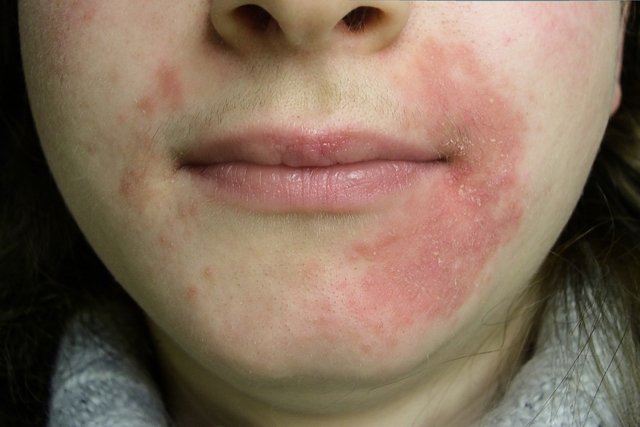Perioral dermatitis is inflammation of the skin around the mouth that causes symptoms such as redness, peeling or dry skin and red bumps. These symptoms especially tend to worsen after stopping the use of corticosteroid ointments.
Although perioral dermatitis does not have a specific cause, it is more common in women between 15 and 45 years old. It can also appear in people who use inhaled corticosteroids and ointments, particularly when these medications are used without medical advice.
If you suspect you may have perioral dermatitis, you should consult a dermatologist. Treatment for perioral dermatitis may involve the use of antibiotics in the form of ointments or tablets. It is also important to identify the factor that triggers or worsens symptoms.

Main symptoms
The main symptoms of perioral dermatitis are:
- Red blisters around the mouth
- Dryness and peeling of facial skin
- Redness of the skin
- Itching around the mouth
- Burning sensation on the affected skin
Sometimes, the red blisters can also appear near the nostrils or eyes. When they break, they can release a clear or pus-filled discharge.
Redness tends to worsen after stopping the use of corticosteroid ointments, or with exposure to heat, sunlight or wind. Symptoms can also worsen with make-up use, or before a period.
Online symptom checker
Perioral dermatitis is a type of dermatitis, like contact dermatitis and seborrheic dermatitis. To find out if you have dermatitis, report your symptoms below:
This quz is only a guidance tool, and should not be used to confirm a diagnosis, nor does it replace consultation with a dermatologist or general practitioner.
Possible causes
Perioral dermatitis does not have a specific cause, but it is believed to occur due to changes in the protective function of the skin and the immune system. It may also be a consequence of an imbalance in microorganisms that live on the surface of the skin.
Perioral dermatitis is more common in women between 15 and 45 years old, and can appear as a result of using corticosteroid ointments on the face, inhaled corticosteroids, cosmetics and facial sunscreens.
Perioral dermatitis can also sometimes be caused by seborrheic dermatitis or contact dermatitis, which is why it is important to consult a dermatologist to confirm the diagnosis and indicate the most appropriate treatment.
Treatment options
Treatment of perioral dermatitis involves the use of ointments prescribed by the dermatologist, such as metronidazole or clindamycin. These help to reduce the inflammation and discomfort.
However, if the ointments are not effective, the doctor may prescribe oral antibiotics with anti-inflammatory properties, such as tetracycline or doxycycline. These are typically taken for prolonged periods, ranging from 2 to 3 months.
Ointments for perioral dermatitis
Ointments for perioral dermatitis that are initially prescribed for treatment will typically contain metronidazole, clindamycin, erythromycin, sulfur or azelaic acid in their composition. It may take a few weeks before they take any noticeable effect.
Sometimes the dermatologist may also prescribe the use of oral antibiotics at the beginning of treatment to reduce skin inflammation more quickly.
Furthermore, it is important to avoid using ointments containing corticosteroids when treating perioral dermatitis, as they can worsen symptoms.
Home remedies
Home remedies for perioral dermatitis that can complement medical treatment include:
- Do not use corticosteroid ointments without medical advice
- Try to identify possible triggers of dermatitis, such as heat, wind, sunlight, moisturizing creams, skin cleansers or toothpastes
- Avoid using products that may be worsening dermatitis, especially until the peeling and redness of the skin improves
- Wear caps and sunglasses to protect your skin from the sun
- Avoid hot environments, and keep the house airy and ventilated
Additionally, compresses with boric acid water, thermal water or iced chamomile tea, which have anti-inflammatory properties, can also be recommended to complement the treatment recommended by the dermatologist.
